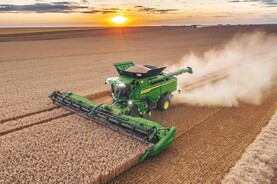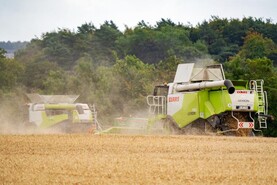A total of 40 new combine harvesters were registered in Ireland in 2022, compared with a total of 57 machines in 2021, a 30% drop, according to the Farm Tractor and Machinery Trade Association (FTMTA).
The 11-year new combine registrations average is at 42.5 machines annually, meaning 2022 is 6% behind. The big story of 2022 is that if combine sales mirrored registrations, they should have been far above average, but severe supply chain issues hit the delivery of new combines to the Irish market. It’s estimated that a further 15-16 new combines were sold in Ireland in 2022, but failed to be delivered, so won’t show up in the 2022 data.
The leading combine manufacturers haven’t shied away from speaking about the tough year they encountered. Many manufacturers had machines assembled, but a range of missing parts meant units couldn’t be delivered.
A share of Irish farmers, and farmers across Europe, had combines traded while waiting on new machines. These trade-ins were subsequently sold on by the dealer, before realising manufacturers could not come up with the delivery of the new machine. This left dealers and manufacturers scrambling to source temporary replacements for the harvest, some of which even had to be imported.
Taking the market leader Claas as an example, during the year I was lucky enough to visit its combine factory at Claas HQ in Harsewinkel, Germany. I saw a huge number of machines assembled, but missing parts meant units couldn’t be delivered.
However, the manufacturer said it stood over its promises. “We delivered and proved with a lot of personal commitment that we can measure up to our vision of making customers the best in their field. We have delivered 100% on our harvest promise to our customers,” said Claas CEO Thomas Böck. Such a commitment had a knock-on effect, with the manufacturer’s net income for 2022 down significantly, dropping from €272.6m in 2021 to €88.1m in 2022, a 67.7% hit in the space of a year.
This was not unique to Claas. All manufacturers struggled to deliver machines on time, and many of these machines have yet to be delivered. The general report is that certain models proved more difficult to secure, such as walker combines over rotary machines.
In terms of the outlook, there are mixed reports but many have noted signs of supply chain issues easing.
The most recent data shows there were 32 used combines first-time registered in Ireland for the year to the end of August, compared with 37 used combines registered for the same period in 2021, noting a 13.5% drop.
Wexford dominated the new combine harvester market with 10 new machines registered, and five used machines registered.
Kildare accounted for six new combine harvester registrations along with three used imports, while counties Meath and Tipperary each shared an equal five new registrations. Cork had the highest number of imported used combine harvester registrations at eight units.
Foragers
According to the FTMTA, a total of 40 new forage harvesters have been registered in the Republic of Ireland in 2022. This means the 2022 figure is one unit (2.5%) behind 2021, but it is up 12.5% on the 11-year average of 35 units annually.
Forager registrations were also affected by the supply chain issues, but not as much, as the Irish Farmers Journal understands that all machines were delivered by the end of August. The county that had the highest number of new registrations was Cork, with a total of 10 new machines registered, followed by Tipperary with seven and Carlow in third position with four new machines registered.
A total of eight used forage harvesters were registered during 2022. Nine new self-propelled mowers were registered, up one on last year, alongside three used self-propelled mowers.






 This is a subscriber-only article
This is a subscriber-only article












SHARING OPTIONS: